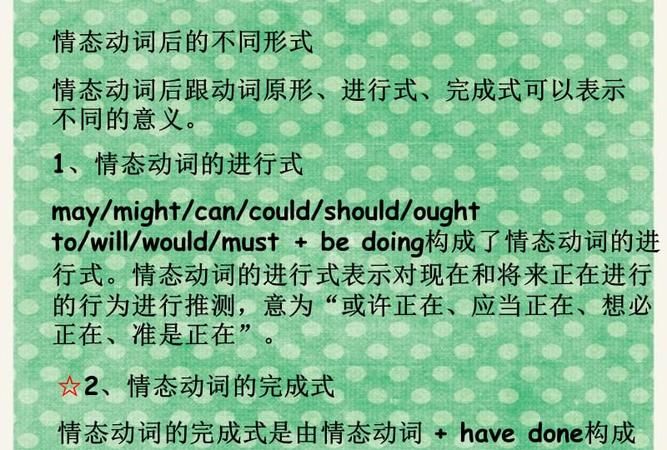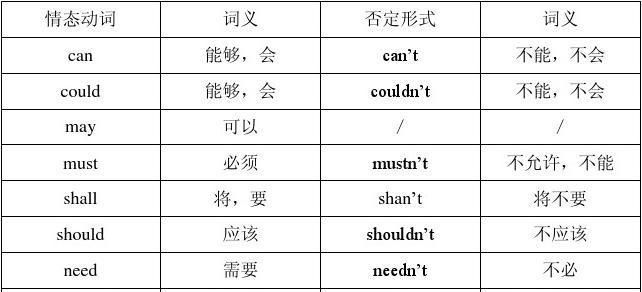本文目录
什么是情态动词
摘要
情态动词常见的有can (could)、may (might)、must、need、ought to、dare (dared)、shall (should)、 will (would)。
咨询记录 · 回答于2021-07-29
什么是情态动词
情态动词常见的有can (could)、may (might)、must、need、ought to、dare (dared)、shall (should)、 will (would)。
情态动词(Modal verb)本身有一定的词义,表示语气的单词。但是不能独立作谓语,只能和动词原形一起构成谓语。情态动词用在行为动词前,表示说话人对这一动作或状态的看法或主观设想。

小学英语的情态动词有哪些
情态助动词
1.情态助动词包括will,would,shall,should,can,could,may,might,must,need,dare,ought
to,used
to等,后接原形不定式。
2.情态助动词不受主语的人称和数的限制。
3.两个情态助动词不能连用。

情态动词有哪些
主要有: can、 could、 may、 might、 must、 need、 ought to、dare、 dared、 shall、should、will would等等。 情态动词在句子中是没有人称和数的变化,常用来表示委婉的语气。
一般情况下, 情态动词在英语句子中主要有四层含义。
1、情态动词可以用来表示能力、体力、知识、技能等等。
例:Can you swim?
翻译:你会游泳吗?
2、 情态动词可以用来表示请求和允许。
例: Can I go to your home?
翻译:我可以去你家吗?
3、情态动词可以用来表示客观可能性,要是指客观的原因。
例:The pool can hold sixty children swimming.
翻译:这个游泳池可以容纳六十个孩子游泳。
4、情态动词可以表示推测,主要用在疑问句、否定句和感叹句中。
例: Can this new is true?
翻译:这个消息是真的吗?

扩展资料:
一、can
1、含义:aux. 可以;能。n. 罐头。v. 罐装;<口>解雇。
2、用法
can用作情态动词的基本意思是“能,能够”“可以”“可能,会”,可表示体力、智力能够完成一件事情或环境赋予的能力; 也可表示由于环境或其他因素而产生的可能性,用于疑问句或否定句中; 还可表示环境、条件或法律的许可。can也可表示要求、拜托、请求、惊讶等。
How can you say that?
你怎么可以这样说?
二、need
1、含义:v. 需要;必需。n. 需要;必要;缺乏。aux. 需要,必须(无时态、人称变化,后与不带 to 的动词不定式连用,多用于疑问句和否定句)。
2、用法
need用作情态动词时没有人称、时态及语态的变化,后面须接不带to的动词不定式一起用作谓语,表示“必须,必要”。一般只用于否定句或疑问句中,也可用于含有否定意味的肯定句中。
need用作实义动词的基本意思是缺少急切需要的东西,强调急需。
need是及物动词,可接名词、代词、动词不定式、动名词作宾语,也可接以动词不定式或过去分词充当补足语的复合宾语。
I don't have the need for such an expensive car like that.
我还不需要一辆那么昂贵的汽车。
小学英语中的情态动词有哪些
情态动词有:
can, could, may, might, ought to, have to, need, shall, should, will, would, dare
情态动词有can (could), may (might), must, have to, shall (should, will (would), dare (dared), need (needed), ought to等。 情态动词无人称和数的变化;不能单独使用,必须与其后的动词原形构成谓语
一、 can, could
1) 表示能力(体力、知识、技能)。
Can you lift this heavy box?(体力)
Mary can speak three languages.(知识)
Can you skate?(技能)
此时可用be able to代替。Can只有一般现在时和一般过去式;而be able to则有更多的时态。
I’ll not be able to come this afternoon.
当表示“经过努力才得以做成功某事”时应用be able to,不能用Can。如:
He was able to go to the party yesterday evening in spite of the heavy rain.
2) 表示请求和允许。
---Can I go now?
--- Yes, you can. / No, you can’t.
此时可与may互换。在疑问句中还可用could,
might代替,不是过去式,只是语气更委婉,不能用于肯定句和答语中。
---- Could I come to see you tomorrow?
---- Yes, you can. ( No, I’m afraid not. )
3) 表示客观可能性(客观原因形成的能力)。
They’ve changed the timetable, so we can go by bus instead.
This hall can hold 500 people at least.
4) 表示推测(惊讶、怀疑、不相信的态度),用于疑问句、否定句和感叹句中。
Can this be true?
This can’t be done by him.
How can this be true?
二、 may, might
1) 表示请求和允许。might比 may语气更委婉,而不是过去式。否定回答时可用can’t
或mustn’t,表示“不可以,禁止”。
----Might/ May I smoke in this room?
---- No, you mustn’t.
---- May/Might I take this book out of the room?
---- Yes, you can. (No, you can’t / mustn’t. )
用May I...?征徇对方许可时比较正式和客气,而用Can I...?在口语中更常见。

以上就是关于0个常见情态动词 ,什么是情态动词的全部内容,以及10个常见情态动词 的相关内容,希望能够帮到您。

